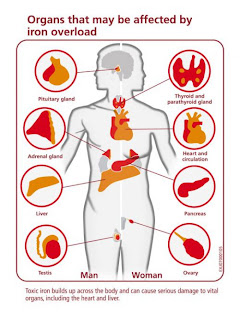Hypoglycemia means low blood sugar level, although “unstable blood sugar levels” would have been more fitting. This term is used to describe a metabolic disorder, that may manifest itself in a variety of physical and 'psychological' symptoms. One must understand that glucose is a source of both physical (muscle) and mental (brain) energy. The brain, representing only 2 percent by weight of the body, has no energy stores of its own. It requires about 60 per cent percent of the all available glucose in the body and consumes about 120 grams per days regardless of whether we are asleep or awake (Source). About one teaspoon of glucose is available in the blood at any time. Hence, the brain is the most sensitive organ in the body to react to unstable blood sugar levels. Hypoglycemic symptoms usually involve the brain as one factor. Most doctors believe that hypoglycemia is due to "insulin resistance", which it shares with diabetes. see Robyn Cosford As in diabetes, when a patient injects excess insulin, it causes the blood glucose concentrations to crash. This will trigger the release of adrenaline - a stress hormone - to increase glucose supply to the brain. These stress hormones are inevitably involved with symptoms of hypoglycemia. This happens in non-diabetic hypoglycemia when the body produces too much insulin called hyperinsulinism. Consequently any extreme fluctuation in the supply of glucose to the brain will inevitably affect our emotions, feelings and personality. Hypoglycemia (or pre-diabetic insulin resistance) is also an important factor in the metabolic syndrome and therefore if you want to avoid diabetes and/or the metabolic syndrome you need to treat the hypoglycemia by nutritional means.
Symptoms
Double vision or blurry vision
Fast or pounding heartbeat
Feeling cranky or acting aggressive
Feeling nervous
Headache
Hunger
Shaking or trembling
Sleeping trouble
Sweating
Tingling or numbness of the skin
Tiredness or weakness
Unclear thinking
Sometimes your blood sugar may be too low, even if you do not have symptoms. If your blood sugar gets too low, you may:
Faint
Have a seizure
Go into a coma
Treatment
The first thing to be done when experiencing hypoglycemia is to bring up the levels of blood sugar back to its normal values. This is achieved by ingesting a hard candy or any food products rich in carbohydrates. Diabetics should always carry an emergency supply of carbohydrates, such as hard candy, just in case hypoglycemia strikes. They should also be familiar with their bodies so as to readily detect early symptoms of hypoglycemia and start treatment at once so as to avoid further complications that may arise from it. Begin treatment of hypoglycemia promptly when symptoms of low levels of blood sugar are felt, even if there is a possibility that the symptoms presented are not from hypoglycemia, it is always safer to presume that the symptoms are caused by hypoglycemia.
More Information
www.quizdoc.com
www.essortment.com






























